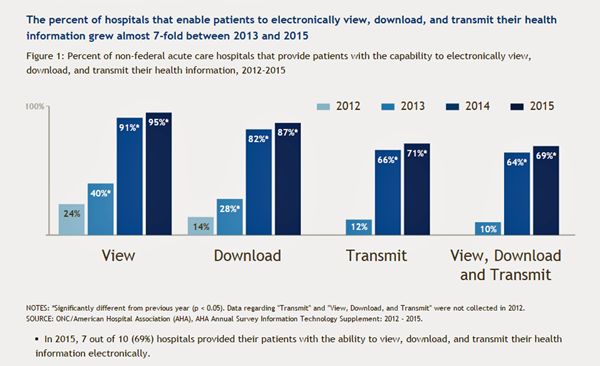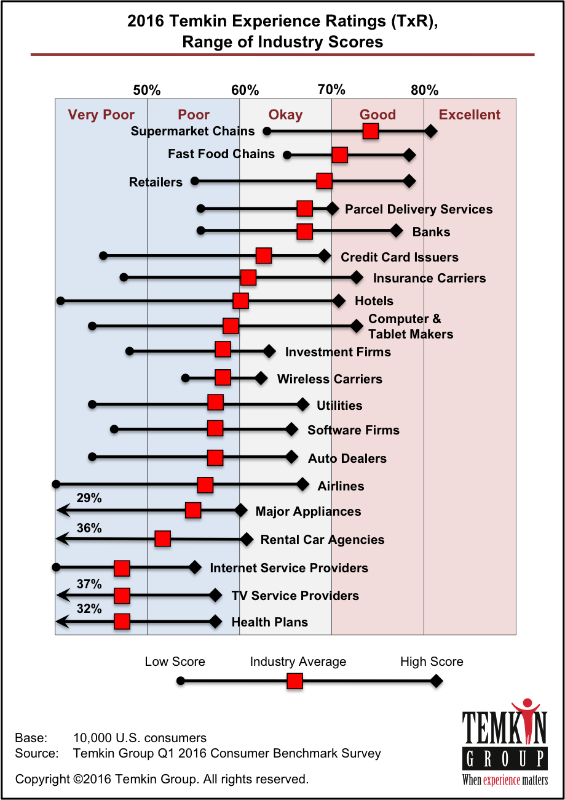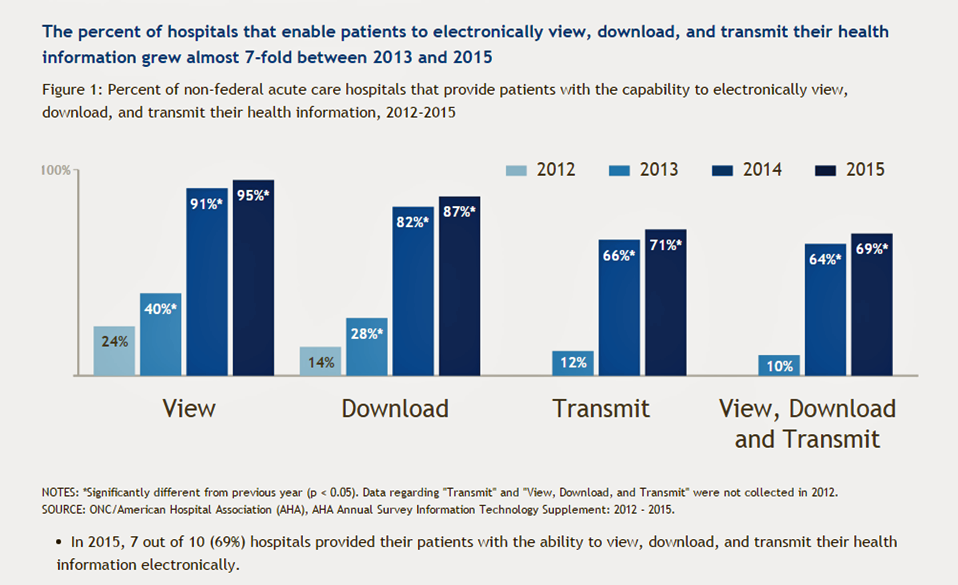 The number of hospitals offering patients electronic access to their health information grew seven times between 2013 and 2015. Electronic health records access has gone mainstream in America, according to the latest findings by The Office of the National Coordinator for Health Information Technology (ONC-HIT).
The number of hospitals offering patients electronic access to their health information grew seven times between 2013 and 2015. Electronic health records access has gone mainstream in America, according to the latest findings by The Office of the National Coordinator for Health Information Technology (ONC-HIT).
The data are detailed in Electronic Capabilities for Patient Engagement among U.S. Non-Federal Acute Care Hospitals: 2012-2015, an ONC Data Brief.
Two in three U.S. patients can now view, download, and transmit their personal health information, shown in the bar chart. This hockey-stick growth, from 10% in 2013 to 69% in 2015, results from the HITECH Act, part of the Stimulus Bill which provided financial incentives to health care providers to adopt and implement electronic health records (EHRs).
95% of hospitals currently provide patients the ability to electronically view their personal health information, followed by 87% of hospitals that enable patients to download their data, and 71%, the ability to transmit personal health information.
Hospitals that offer the three EHR functions to patients tend to be larger institutions: fewer critical access and smaller hospitals provide patients with the ability to electronically view, download, and transmit their health information. Transmitting data is a bigger challenge for smaller institutions.
There are additional electronic record capabilities that many hospitals offer patients, including:
- Requesting amendments to the records, 77% of hospitals
- Paying bills, 74% of hospitals
- Sending or receiving secure messages to clinicians, 63% of hospitals
- Scheduling appointments, 44%
- Requesting Rx refills, 42%, and
- Submitting patient-generated data (like weight, “Fitbit” health tracking data, blood pressure read-outs, etc.), 37%. This has grown 3x between 2013 and 2015.
ONC points out in the report’s conclusion that, “future research that investigates divergent trends in hospital adoption of patient engagement functionalities will provide important insights on how to ensure that all patients have access to their health information and are actively engaged with their health care provider.”
 Health Populi’s Hot Points: Patients’ experience is playing a growing role in calculating hospital payment, with tools like the HCAHPS scores measuring how people feel about their hospital stay or physician visit. HCAHPS is the acronym for “Hospital Consumer Assessment of Healthcare Providers and Systems,” which captures patients’
Health Populi’s Hot Points: Patients’ experience is playing a growing role in calculating hospital payment, with tools like the HCAHPS scores measuring how people feel about their hospital stay or physician visit. HCAHPS is the acronym for “Hospital Consumer Assessment of Healthcare Providers and Systems,” which captures patients’
The Emerging Importance of Patient Amenities in Hospital Care, an article in the New England Journal of Medicine, was published in December 2010. The authors discussed the so-called medical arms race of hospitals acquiring new-and-improved MRIs, new waiting room furniture, and other shiny new things that may or may not have returned a hard ROI on their spend.
Who doesn’t like amenities? When we’re patients, we’re now consumers/customers as well. And the experience will continue to be measured by HCAHPS and other patient assessment tools which will play important roles in providers getting paid to the fullest extent they can (that is, including bonuses and hold-backs earmarked for patient satisfaction).
The patient experience today also encompasses the streamlined digital experience, as millions of consumers pay $99 a year for Amazon Prime to receive goods quickly. Note the 2016 Temkin Experience Ratings chart, which shows that supermarkets and retailers and “UPS” rank at the top of consumer experience; and, health insurers at the bottom along with internet service providers and cable TV.
The healthcare industry, and particularly providers exposed to patients enrolled in high-deductible health plans, will need to take a page out of the best digitally-enabled companies, who are very-much valued for delivering digitally.
Most providers are offering digital access to patients for personal health information and other healthcare administrative and clinical tools. But a plethora of patients still isn’t using that access, as I discussed in Health Populi last week in Consumers Seek Quality and Privacy in Tech-Enabled Healthcare. Health engagement doesn’t just include a patient taking her medicine on-time and as-prescribed. Engagement also means patients accessing, understanding, and acting on their health information.





 Thank you, Trey Rawles of @Optum, for including me on
Thank you, Trey Rawles of @Optum, for including me on  I was invited to be a Judge for the upcoming
I was invited to be a Judge for the upcoming  For the past 15 years,
For the past 15 years,